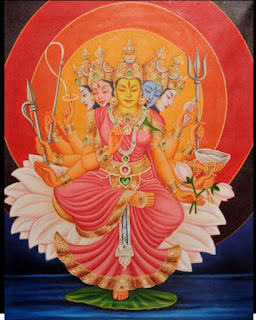अप्रमेया (413)
Aprameyā
She cannot be measured. She's Brahman. Because She is aprameyā, She is worshipped by jñāni-s and śiṣṭa-s.
Viṣṇu Sahasranāma nāma 46 is also aprameyā. He cannot be known through senses as He is devoid of qualities such as sound, etc. He cannot be visualized because He is beyond visualisation. He cannot be known through examples because there is nothing to make a comparison. He cannot be known either by affirmations or by negations as we do not have any basis for such affirmations and negations. But Veda-s and Upaniṣads try to explore Him as “That” and says that He exists as self-illuminating light witnessing the activities of His creation.
स्वप्रकाशा (414)
Svaprakāśā
She is Self-illuminating. Brahman alone is self-illuminating and all other illuminating objects like sun, moon, stars etc derive their light only from the Brahman.
मनो-वाचामगोचरा (415)
Mano-vachāmagocharā
She is beyond mind and speech.
She can be realized only through pure knowledge.
चिच्छक्तिः (416)
गायत्री (420)
Gāyatrī
व्याहृतिः (421)
Vyāhṛtiḥ
Lalitāmbikā is said to be in the form of Gāyatrī. The appropriate way of interpretation is that Gāyatrī is one among the multitude manifestations of Lalitāmbikā. Amongst all the mantras, Gāyatrī mantra is considered as the most sacred one.
Vyāhṛti-s represent the three types of worlds. (The names of the seven worlds are bhūḥ, bhuvaḥ, svaḥ, mahaḥ, janaḥ, tapaḥ, satyaṁ. The first three are called the great vyāhṛiti-s.
Three loka-s or worlds mean the three stages of consciousness. Bhūr means the lower level of consciousness and lower planes. Bhuvar means the ordinary or normal level of consciousness that is associated with our day to day activities.
She is in the form of vyāhṛti-s of Gāyatrī mantra .
सन्ध्या (422)
Sandhyā
Sandhyā means non-separation.
The three important nādi-s in kuṇḍalinī meditation iḍā, piṅgalā and suṣumna meet at ājñā cakra. This place is called sandhya as sandhya also means joining.
द्विजबृन्द-निषेविता (423)
Dvijabṛnda-niṣevitā
She is worshipped by those who recite Gāyatrī mantra. Those who recite Gāyatrī mantra are called dvijā-s or twice born. Twice born because, first birth through the mother and second birth is the initiation of Gāyatrī mantra.
तत्वासना (424)
Tatvāsanā
Tattva-s mean the principles. She is seated on these tattva-s . It can also be said that She is beyond these tattva-s.
तत् (425)
Tat
The Brahman is referred to by three qualities. They are ‘om’ ‘tat’ ‘sat’ (Om tat sat). Tat means “That”. She is That and this That means the Brahman.
त्वम् (426)
Tvam
Tvam means you, indicating Her. Here tvam means the Brahman.
अयि (427)
Ayi
Ayi is a way of addressing mother or sister. Since She is the supreme mother of the universe, She is addressed as ayi.
पञ्च-कोशान्तर-स्थिता (428)
Pañca-kośāntra-sthitā
She resides in the five sheaths covering of human organism, which is also called piṇḍa śarīra.
निःसीम-महिमा (429)
Niḥsīma-mahimā
Her greatness has no boundaries, as the Brahman is omnipresent. Niḥsīman means immeasurable.
नित्य-यौवना (430)
Nitya-yauvanā
She is eternally youthful, as She is beyond space and time.
मद-शालिनी (431)
Mada-śālinī
She is in the stage of ānanda, the stage of bliss.
मद-घूर्णित-रक्ताक्षी (432)
Mada-ghūrṇita-raktākṣī
Her eyes have natural red tinge.
मद-पाटल-गन्ड-भू: (433)
Mada-pāṭala-ganda-bhuḥ
Because of Her blissful state, Her cheeks blush with red colour.
चन्दन-द्रव-दिग्धाङ्गी (434)
Chandana-drava-digdhāṅgī
Her body is smeared with sandal paste. Sandal paste is said to cool down the internal body heat.
चाम्पेय-कुसुम-प्रिया (435)
Chāmpeya-kusuma-priyā
She is fond of champaka flower (michelia Champaka).
कुशला (436)
Kuśalā
She is skilful.
कोमलाकारा (437)
Komalākārā
She has beautiful and tender body. She has a graceful form.
कुरुकुल्ला (438)
Kurukullā
Kurukullā is a goddess who dwells in Śrī Cakra between the boundaries of ego and consciousness. The Bhāvanopaniṣad considers goddess Vārāhi as father and Kurukullā as mother.
कुलेश्वरी (439)
Kuleśvarī
She is the ruler of the triad kula. The triad consists of cognisor, cognized and cognition (the psychological level of perception). She controls this triad that leads to Self-realisation. If all the three become one, She is realised.
कुलकुण्डालया (440)
Kulakuṇḍālayā
Kulakuṇda is a small orifice in mūlādhāra cakra, where She takes rest.
Saundarya Laharī (verse 10) also says, “Reaching your own ground mūlādhāra and coverting yourself into a serpent with three coils and half, You sleep in the crevice in the centre of mūlādhāra lotus.”
A practitioner’s spiritual pursuit begins from Kulakuṇda that transcends upwards to turya and turyātīta stages where bliss and salvation take place.
कौल-मार्ग-तत्पर-सेविता (441)
Kaula-mārga-tatpara-sevitā
She is worshipped by those who follow the kaula tradition. Kaula way of worship is purely based on tantric rituals.









No comments:
Post a Comment